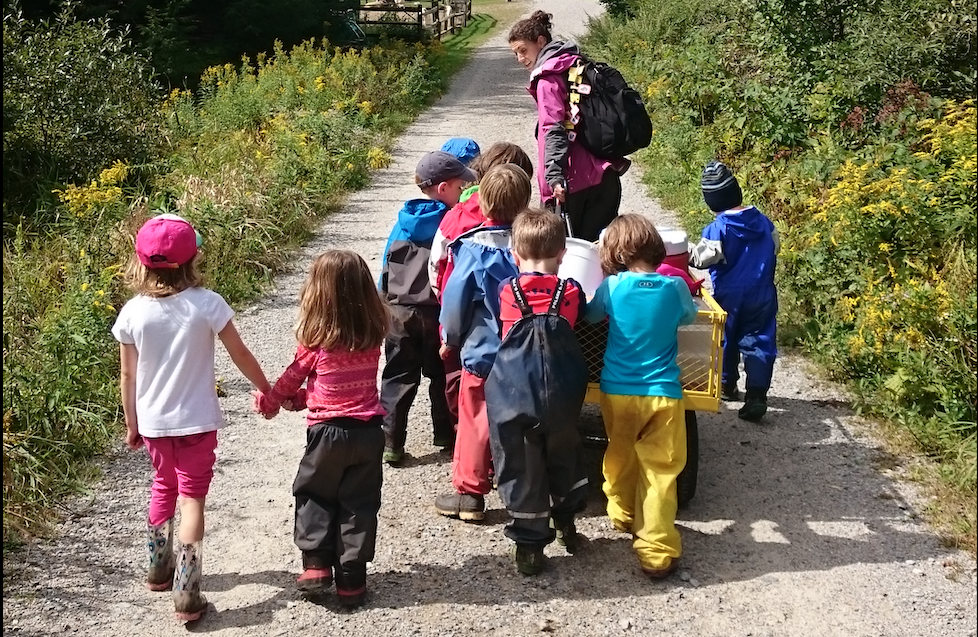Outside has become the new inside. This isn’t just true for socializing during the pandemic. It’s also increasingly true for the classrooms in which students across the country are studying. Instead of wedging students into colorful plastic seats in traditional, indoor classrooms, a growing movement suggests that some of the best learning can happen out under the open sky.
For more than a decade Antioch University New England has been at the forefront of this movement, but this work has had special relevance and found new and wider audiences this last year—a year when gathering inside has had potentially lethal consequences. From the release of two position statements about using outdoor learning to keep schools open during COVID-19 to continued growth in the Nature-Based Early Childhood Education program and even a feature on the New York Times’s Wirecutter website, it has been a big year for these Antiochians who advocate bringing the classroom outside. And the coming year promises even more.
Using the Outdoors to Keep Schools Open
When it became clear a year ago that schools might be sites of transmission of COVID-19, almost every school district in the U.S. closed overnight. Students had to learn from home, staring at screens instead of gathering in classrooms. This put an extra burden on parents, who had to now supervise their children’s learning, and it placed a strain on teachers, who had to adapt overnight to a very different medium for their instruction. But possibly the worst result was that many students—particularly those already living in poverty—simply dropped out of the educational system. A national tragedy, with costs that won’t be fully tallied for decades, played out.

One of the most interesting proposals for how to remedy this came from the Inside-Outside network of nature-based educators, a project of Antioch University New England. Last July they released a position statement titled “Outdoor Learning Opportunities for Healthy Students: a Solution for Elementary Schools During COVID-19.” In it the authors explain how to successfully implement learning outdoors. Emphasis is placed on the fact that nature-based learning looks different for all who take part, and it does not mean being outdoors all day. Nature-based learning can be facilitated in scheduled sessions, part of the day, or just with certain lessons being taught outside. Moving the classroom outdoors to avoid transmission and promote learning and mental wellness seems to be the ideal solution during COVID-19, particularly during a time where everyone has craved some form of normalcy and social interaction.
Later, as winter set in, Inside-Outside released another position statement, this time titled “Outdoor Learning in Cold Weather: Keep Moving through Winter and COVID–19.” Authors explain here that outdoor learning during the winter months can take place safely when students, teachers, and all other participants are dressed in warm clothing, remain hydrated, and have access to shelter and restrooms. Both statements present well-argued stances on why outdoor classrooms are beneficial while also giving practical tips for successfully navigating the transition outdoors. Authors advise teachers and students to still wear masks, practice social distancing, and wash hands regularly.
Liza Lowe, the director of Inside-Outside, is a graduate of the MEd in Elementary Education at Antioch New England. Today she also teaches as affiliate faculty at the New England campus, and she says that the benefits of bringing students outside extend far beyond the confines of COVID-19. Nature awakens students in a way the indoor classroom cannot. “Children’s love of learning feels more tangible outside,” Lowe explains. “It is limitless and diverse, as they access learning in a way that can be different than inside.” The walls come down literally and figuratively—students connect with lessons on a deeper level when they can get their hands dirty by engaging with the earth—squeezing the soil between their fingers, observing insects and other creatures in their natural habitat, exploring the community, and running and laughing with their peers while doing it.
Lowe has grown Inside-Outside into a thriving network whose mission has been to support and connect outdoor educators with a like-minded community. Having a supportive community builds confidence. “Educators need to feel validated,” Lowe says. “We see them. We see how important their work is and we value it. That’s why we’re here.” Not only does Inside-Outside support educators but keeps them connected and up-to-date about the evolving field of nature-based education.
Preparing a New Generation of Outdoor Educators
The interactive, discover-by-doing approach to learning that is birthed in outdoor classrooms is driving a new generation of instructors to pursue nature-based education as the root of their educational practice. Antioch New England currently offers two avenues for teachers to gain proficiency in this field: a Certificate in Nature-Based Early Childhood Education and a Masters of Education with a concentration in Nature-Based Early Childhood Education. Both options train educators to work as teachers, administrators, or even founders of their own nature preschools or forest kindergartens.

The guiding philosophy of the Nature-Based Early Childhood Education program can be summed up in the words of David Sobel, teaching faculty and the programs’ founder. He encouraged educators to “Give children a chance to love the earth before we ask them to save it.” The program is grounded in encouraging young children to experience nature and develop meaningful connections to their surroundings as well as with their teachers and peers.
Ellen Doris, the current director of the Nature-Based Early Childhood Education program says, “At the heart of the program is the belief that young children benefit from opportunities to spend time in nature, supported by caring adults. We want outdoor play and learning to be part of every childhood so that all children can develop sturdy, loving connections to nature and to their communities.”
The program is innovative in its approach and curriculum, offering various learning options to support educators at any stage of their careers who desire to expand their expertise. From the year-long Certificate Program to the NbEC specialization within the Integrated Learning-Teacher Certification Program and the NbEC Concentration within the Experienced Educator MEd degree program, there are pathways to suit many different students.
Lowe explains that the NbEC program is perfect for those who desire a unique learning experience. “We model with our students how we want them to teach in their outdoor classrooms. We engage in singing and other activities to connect our students back to their childhood selves. This creates a dynamic educator.”
In all of these programs, students have the opportunity to transfer their real-world understanding and experience into credits they can apply towards their degree. Ultimately, graduates are prepared to create vibrant outdoor classrooms in which children have space to engage with nature, explore the world around them, and venture independently, building self-confidence and independence.
The Right Gear for Snowy, Muddy, or Muggy Days Outside
Lowe, along with another outdoor educator, was recently featured in an article, “How to Play Outside More This Winter, According to Outdoor-School Teachers” in The New York Times’s Wirecutter site, which is focused on reviewing consumer products. In the article, Lowe gives tips on how to venture outdoors more during the winter, integrating outdoor fun into the many activities of the day, not focusing on the weather but on the fun that can be had among nature.

“My messaging to parents, colleagues, and other teachers is to not look at the weather as good or bad. It’s just another part of your day,” Lowe says in the article. “Use the weather and the changing seasons as teachable moments, rather than focusing on whether it’s cold.”
She goes on to recommend dressing in layers, wearing rain pants rather than snow pants, and setting up children’s clothing areas in such a way that they can experience independence by dressing themselves. The whole article is worth reading, but the big takeaway is that with a little preparation children and their parents can enjoy the outdoors no matter the weather.
Ending the Pandemic—But Keeping the Outside Classrooms
As vaccination rates rise daily across the nation, many are looking forward to a return to normalcy, to a world much like the one that existed before COVID-19. But Lowe and the other Antiochians promoting nature-based education hope that newly-formed habits that bring people of all ages closer to nature will not be lost. “Pre-COVID, nature-based education was on the rise,” says Lowe. “COVID forced us to rethink learning. It forced us out of our comfort zones and we had to think outside of the box.” Nature-based learning is a solution–a way of the future where we can connect to our childhood selves and relish in the sights, sounds, and smells all around us.






